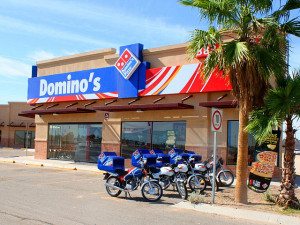Domino’s Pizza: A Slice of Life
[dropcap]T[/dropcap]he likelihood, if you are reading this article, is that you are a student. And if you are a student, there is also a fairly high chance that you have enjoyed a Domino’s pizza at some point in your life. The ubiquity of the brand speaks for its popularity, and a fair few people have started their work careers at one of its stores (myself included).
But what really goes on behind the scenes? If you aren’t part of the Domino’s world, the restaurant can seem a completely foreign place, far away from the menu deposited in your kitchen during Fresher’s.
A Channel 4 documentary called Domino’s Pizza: A Slice of Life aired on 11 June, opening the doors to the viewing public for the first time. I watched, eager to see how they would present a business that I was familiar with.
Channel 4’s presentation of the company was partly true to life, but the network looked at some more obsessive types, because that is obviously better television. Indeed, I had never heard of our supposed mascot, Danny Domino, until this show.
As with all documentaries, we were given a number of figures to follow and to connect with, and an overarching story to prevent things getting too dull. We had Matt, a store manager in Llanelli who loves Domino’s so much that he credits it with both saving him from a life of crime, and for helping him to marry his wife at a global gathering of Domino’s employees.
We also had Zagros, a refugee from Iraq who is able to make three pizzas in a minute. And we had Eddie, a franchisee in Rotherham, who we followed opening his tenth store.
I had expected it to be a more general documentary, but that wouldn’t have been so interesting. Sure, we had a bunch of facts about the ingredients and utensils used (the company goes through 240 tonnes a week in cheese alone, for example), but the majority of the show focused on the Dominoids – people so obsessed with the store that they “bleed sauce and spit cheese.” Now there’s an image to hold in your mental vaults for the next time you order.
We saw some things that I can only describe as confusing and a touch scary. There’s a Domino’s training school where people are trained to slap (make the base), top, and perform other pizza skills with imaginary pizzas, in a manner so like a martial arts training montage that it ought to be over-scored by Survivor.
More terrifying than that are the many scenes of employees repeating the Domino’s chant, something that was clearly designed by a former cult leader. However, I digress from the story…
Matt was in the running to be Store Manager of the Year at the big Domino’s convention, as was Zagros. Obviously, this story was going to have an unhappy ending for one of our heroes, and it was Matt who failed take home the big prize. Meanwhile, Zagros was eager to retain his record as the UK’s pizza maker at the Fastest Pizza Making Championship. The winner becomes company royalty and gets to enjoy a cash incentive. The event is taken incredibly seriously – it even has its own sporting terminology (a competitor can suffer from the ‘pepperoni shakes’ when they get nervous).
Obviously, an hour-long documentary is not enough time to look in any particular detail at an entire subject, but, on the whole, I felt a nice balance was found
The main problem that struck here was the problem that strikes most documentaries – that the everyday and the mundane is exactly that, and thus would not make good television. Sure, a busy shift feels dramatic at the time, but I imagine that Channel 4 broadcasting it would be enough to turn people onto Channel 5!
As a Domino’s employee, parts of this documentary were slightly familiar (no-one wants to see a red screen on a busy night), but it seemed less a reflection on the business so much as a look at some of the more obsessive parts of the business.
Somewhat biasedly, though, I found it interesting and would recommend it. If nothing else, helping the general public learn that there is a human side to the company is more than important enough.



Comments